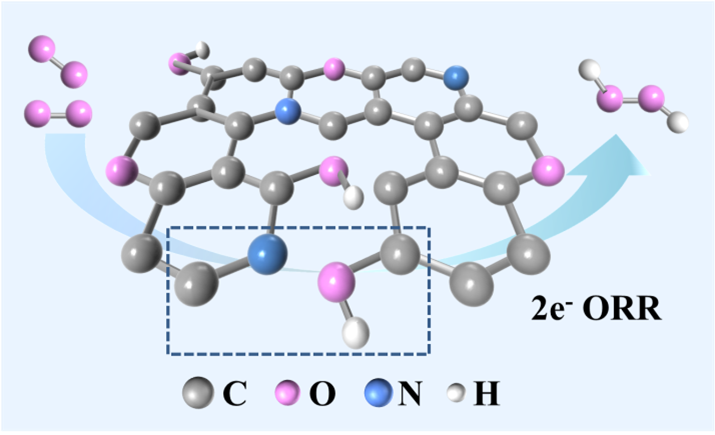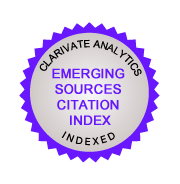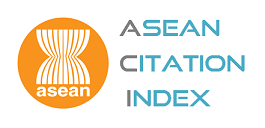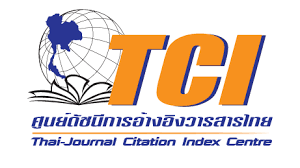Hydroxyl combined with nitrogen on biomass carbon promotes the electrocatalytic H\(_{2}\)O\(_{2}\) selectivity
DOI:
https://doi.org/10.55713/jmmm.v35i1.2216Keywords:
Electrocatalysis, Biomass carbon, Two-electron oxygen reduction reactionAbstract
Elevating the selectivity of two-electron oxygen reduction reaction (2e‒ ORR) is challenging. Herein, the hydroxyl combined with nitrogen on biomass carbon exhibits a high H2O2 selectivity over a wide potential range of 0 V to 0.5 V vs. RHE, which is nearly 97% at 0.3 V vs. RHE. The combination of hydroxyl and nitrogen improves the adsorption and desorption of intermediates, finally changing the reaction pathway and promoting the selectivity of 2e‒ ORR. The Faradaic efficiency (FE) reaches 98% at 0.3 V vs. RHE. Furthermore, the typical organic pollutants were degraded on site in flow cell. This work illustrates the potential of biomass carbon in 2e‒ ORR.
Downloads
References
X. Zhou, Y. Min, C. Zhao, C. Chen, M.-K. Ke, S.-L. Xu, J.-J. Chen, Y. Wu, and H.-Q. Yu, “Constructing sulfur and oxygen super-coordinated main-group electrocatalysts for selective and cumulative H2O2 production,” Nature Communications, vol. 15, p. 193, 2024. DOI: https://doi.org/10.1038/s41467-023-44585-1
L. Sun, X. Jin, T. Su, A. C. Fisher, and X. Wang, “Conjugated nickel phthalocyanine derivatives for heterogeneous electro-catalytic H2O2 synthesis,” Advanced Materials, vol. 36, no. 17, p. 2306336, 2024. DOI: https://doi.org/10.1002/adma.202306336
H. Yang, N. An, Z. Kang, P. W. Menezes, and Z. Chen, “Understanding advanced transition metal-based two electron oxygen reduction electrocatalysts from the perspective of phase engineering,” Advanced Materials, vol. 36, no. 25, p. 2400140, 2024. DOI: https://doi.org/10.1002/adma.202400140
M. Mazzucato, A. Facchin, M. Parnigotto, and C. Durante, “New and revised aspects of the electrochemical synthesis of hydrogen peroxide: from model electrocatalytic systems to scalable materials,” ACS Catalysis, vol. 14, no. 9, pp. 6369-6403, 2024. DOI: https://doi.org/10.1021/acscatal.4c01011
Z. Deng, A. H. B. Mostaghimi, M. Gong, N. Chen, S. Siahrostami, and X. Wang, “Pd 4d orbital overlapping modulation on Au @Pd nanowires for efficient H2O2 Production,” Journal of the American Chemical Society, vol. 146, no. 4, pp. 2816-2823, 2024. DOI: https://doi.org/10.1021/jacs.3c13259
Y. Zhang, Z. H. Lyu, Z. Chen, S. Zhu, Y. Shi, R. Chen, M. Xie, Y. Yao, M. Chi, M. Shao, and Y. Xia, “Maximizing the catalytic performance of Pd@AuxPd1−x nanocubes in H2O2 production by reducing shell thickness to increase compositional stability,” Angewandte Chemie International Edition, vol. 60, no. 36, pp. 19643-19647, 2021. DOI: https://doi.org/10.1002/anie.202105137
H. Li, P. Wen, D. S. Itanze, Z. D. Hood, S. Adhikari, C. Lu, X. Ma, C. Dun, L. Jiang, D. L, Y. Qiu, and S. M. Geyer, “Scalable neutral H2O2 electrosynthesis by platinum diphosphide nano-crystals by regulating oxygen reduction reaction pathways,” Nature Communications, vol. 11, p. 3928, 2020. DOI: https://doi.org/10.1038/s41467-020-17584-9
C. Jia, Q. Sun, R. Liu, G. Mao, T. Maschmeyer, J. J. Gooding, T. Zhang, L. Dai, and C. Zhao, “Challenges and opportunities for single-atom electrocatalysts: from lab-scale research to potential industry-level applications,” Advanced Materials, vol. 36, no. 42, p. 2404659, 2024. DOI: https://doi.org/10.1002/adma.202404659
K.-Y. Chen, Y.-X. Huang, R.-C. Jin, and B.-C. Huang, “Single atom catalysts for use in the selective production of hydrogen peroxide via two-electron oxygen reduction reaction: mechanism, activity, and structure optimization,” Applied Catalysis B: Environmental, vol. 337, no. 15, p. 122987, 2023. DOI: https://doi.org/10.1016/j.apcatb.2023.122987
M. Gao, Z.-Y. Wang, Y.-R. Yuan, W.-W. Li, H.-Q. Liu, and T.-Y. Huang, “Ball-milled biochar for efficient neutral electrosynthesis of hydrogen peroxide,” Chemical Engineering Journal, vol. 434, no. 15, p. 134788, 2022. DOI: https://doi.org/10.1016/j.cej.2022.134788
Z. Luo, M. Liu, D. Tang, Y. Xu, H. Ran, J. He, K. Chen, and J. Sun, “High H2O2 selectivity and enhanced Fe2+ regeneration toward an effective electro-fenton process based on a self-doped porous biochar cathode,” Applied Catalysis B: Environmental, vol. 315, no. 15, p. 121523, 2022. DOI: https://doi.org/10.1016/j.apcatb.2022.121523
M. Fan, Z. Wang, K. Sun, A. Wang, Y. Zhao, Q. Yuan, R. Wang, J. Raj, J. Wu, J. Jiang, and J. Wang, “N-B-OH site-activated graphene quantum dots for boosting electrochemical hydrogen peroxide production,” Advanced Materials, vol. 35, no. 17, p. 2209086, 2023. DOI: https://doi.org/10.1002/adma.202209086
D. Li, Y. Guo, Y. Sun, L. Bai, J. Shi, G. Chen, J. Shi, Y. Liu, C. Jin, Z. Yue, J. Bai, K. Leng, J. Xu, and Y. Qu, “Efficient industrial-current-density H2O2 production in neutral medium via external-shell boron regulation on single-atom VN4 sites,” Chemical Engineering Journal, vol. 494, no. 15, p. 153211, 2024. DOI: https://doi.org/10.1016/j.cej.2024.153211
W. Peng, J. Liu, X. Liu, L. Wang, L. Yin, H. Tan, F. Hou, and J. Liang, “Facilitating two-electron oxygen reduction with pyrrolic nitrogen sites for electrochemical hydrogen peroxide production,” Nature Communications, vol. 14, no. 1, p. 4430, 2023. DOI: https://doi.org/10.1038/s41467-023-40118-y
Q. Wang, Y. Lei, D. Wang, and Y. Li, “Defect engineering in earth-abundant electrocatalysts for CO2 and N2 reduction,” Energy Environmental Science, vol. 12, pp. 1730-1750, 2019. DOI: https://doi.org/10.1039/C8EE03781G
Q. Wu, H. Zou, X. Mao, J. He, Y. Shi, S. Chen, R. Yan, L. Wu, C. Lang, B. Zhang, L. Song, X. Wang, A. Du, Q. Li, Y. Jia, J. Chen, and X. Yao, “Unveiling the dynamic active site of defective carbon-based electrocatalysts for hydrogen peroxide production,” Nature Communications, vol. 14, no. 1, p. 6275, 2023. DOI: https://doi.org/10.1038/s41467-023-41947-7
X. Shen, Z. Wang, H. Guo, Z. Lei, Z. Liu, and L. Wang, “Solvent engineering of oxygen-enriched carbon dots for efficient electrochemical hydrogen peroxide production,” Small, vol. 19, no. 43, p. 2303156, 2023. DOI: https://doi.org/10.1002/smll.202303156
Y. Bai, D. Deng, J. Wang, Y. Wang, Y. Chen, H. Zheng, M. Liu, X. Zheng, J. Jiang, H. Zheng, M. Yi, W. Li, F. Guozhao, D. Wang, and Y. Lei, “Inhibited passivation by bioinspired cell membrane Zn interface for Zn-air batteries with extended temperature adaptability,” Advanced Materials, vol. 36, no. 40, p. 2411404, 2024. DOI: https://doi.org/10.1002/adma.202411404
T. Wang, Y. Zhang, B. Huang, B. Cai, R. Rao, L. Giordano, S.-C. Sun, and Y. Shao-Horn, “Enhancing oxygen reduction electrocatalysis by tuning interfacial hydrogen bonds,” Nature Catalysis, vol. 4, no. 9, pp. 753-762, 2021. DOI: https://doi.org/10.1038/s41929-021-00668-0
Q. Wang, S. Tang, Z. Wang, J. Wu, Y. Bai, Y. Xiong, P. Yang, Y. Wang, Y. Tan, W. Liu, X. Xiong, and Y. Lei, “Electrolyte tuned robust interface toward fast-charging Zn-air battery with atomic Mo site catalyst,” Advanced Functional Materials, vol. 33, no. 47, p. 2307390, 2023. DOI: https://doi.org/10.1002/adfm.202307390
P.-Y. Yang, X.-C. Liu, Y.-C. Wang, H.-R. Zheng, J.-X. Wang, J.-Y. Zheng, M.-J. Liu, D.-N. Deng, Y. Bai, Y.-B. Chen, T. Zhang, Z.-M. Liu, and Y. Lei, “The weatherability and heat resistance enhanced by the interaction between AG25 and Mg/Al-LDH,” Rare Metals, vol. 43, no. 6, pp. 2758-2768, 2024. DOI: https://doi.org/10.1007/s12598-023-02605-5
J. Shen, X. Qiu, and Y. Zhu, “Nitrogen-doped sp3 carbon dot catalysed two-electron electrochemical oxygen reduction for efficient production of hydrogen peroxide,” Journal of Materials Chemistry A, vol. 11, pp. 11704-11711, 2023. DOI: https://doi.org/10.1039/D3TA01920A
M. Xu, R. Cao, B. Hao, D. Wang, D. Luo, H. Dou, and Z. Chen, “Single-anion conductive solid-state electrolytes with hierarchical ionic highways for flexible zinc-air battery,” Angewandte Chemie International Edition, vol. 63, no. 36, p. e202407380, 2024. DOI: https://doi.org/10.1002/anie.202407380
G.-F. Han, F. Li, W. Zou, M. Karamad, J.-P. Jeon, S.-W. Kim, Y. Bu, Z. Fu, Y. Lu, S. Siahrostami, and J.-B. Baek, “Building and identifying highly active oxygenated groups in carbon materials for oxygen reduction to H2O2,” Nature Communications, vol. 11, no. 1. p. 2209, 2020. DOI: https://doi.org/10.1038/s41467-020-15782-z
D. Deng, J. Wu, Q. Feng, X. Zhao, M. Liu, Y. Bai, J. Wang, X. Zheng, J. Jiang, Z. Zhuang, X. Xiong, D. Wang, and Y. Lei, “Highly reversible zinc-air batteries at -40℃ enabled by anion-mediated biomimetic fat,” Advanced Functional Materials, vol. 34, no. 2, p. 2308762, 2024. DOI: https://doi.org/10.1002/adfm.202308762
Y. Wang, Q. Li, M. Wang, H. Ou, D. Deng, H. Zheng, Y. Bai, L. Zheng, Z.-Y. Chen, W. Li, G. Fang, and Y. Lei,“Pumping electrons from oxygen-bridged cobalt for low-charging-voltage Zn-air batteries,” Nano Letters, vol. 24, no. 43, pp. 13653-13661, 2024. DOI: https://doi.org/10.1021/acs.nanolett.4c03510
T. Prathumsuwan, S. Kladsomboon, A. A. Christy, I. In, X. Liang, S. Song, Y. Wang, T. Inprasit, P. Paoprasert, and N. Sirisit, “Integration of jackfruit seed-derived carbon dots and electronic nose for a sensitive detection of formaldehyde vapor,” Journal of Metals, Materials and Minerals, vol. 34, no. 1, p. 1846, 2024. DOI: https://doi.org/10.55713/jmmm.v34i1.1846
K. Kitsanadecha, C. Sinmak, P. Onchomchan, K. Hantanasirisakul, T. Kwamman, and S. Anantachaisilp, “Synthesis and characterization of electron beam irradiated glutinous rice husk-derived biochar and activated carbon for aqueous electro-chemical capacitors,” Journal of Metals, Materials and Minerals, vol. 33, no. 3, p. 1687, 2023. DOI: https://doi.org/10.55713/jmmm.v33i3.1687
H. Zheng, D. Deng, X. Zheng, Y. Chen, Y. Bai, M. Liu, J. Jiang, H. Zheng, Y. Wang, J. Wang, P. Yang, Y. Xiong, X. Xiong, and Y. Lei, “Highly reversible zn-air batteries enabled by tuned valence electron and steric hindrance on atomic Fe-N4-C Sites,” Nano Letters, vol. 24, no.15, pp. 4672-4681, 2024. DOI: https://doi.org/10.1021/acs.nanolett.4c01078
Y. Wang, J. Wu, S. Tang, J. Yang, C. Ye, J. Chen, Y. Lei, and D. Wang, “Synergistic Fe-Se atom pairs as bifunctional oxygen electrocatalysts boost low-temperature rechargeable Zn-air battery,” Angewandte Chemie International Edition, vol. 62, no. 15, p. e202219191, 2023. DOI: https://doi.org/10.1002/anie.202219191
J. Zhou, P. Yang, P. A. Kots, M. Cohen, Y. Chen, C. M. Quinn, M. D. de Mello, J. A. Boscoboinik, W. J. Shaw, S. Caratzoulas, W. Zheng, and D. G. Vlachos, “Tuning the reactivity of carbon surfaces with oxygen-containing functional groups,” Nature Communications, vol. 14, no. 1, p. 2293, 2023. DOI: https://doi.org/10.1038/s41467-023-37962-3
H. Wu, W. Yuan, L. Li, X. Gao, Z. Zhang, and Y. Qian, “Ultra-high capacity and stable dual-ion batteries with fast kinetics enabled by HOF supermolecules derived 3D nitrogen-oxygen Co-doped nanocarbon anodes,” Advanced Functional Materials, vol. 34, no. 46, p. 2406540, 2024. DOI: https://doi.org/10.1002/adfm.202406540
S. Chen, T. Luo, K. Chen, Y. Lin, J. Fu, K. Liu, C. Cai, Q. Wang, H. Li, X. Li, J. Hu, H. Li, M. Zhu, and M. Liu, “Chemical identification of catalytically active sites on oxygen-doped carbon nanosheet to decipher the high activity for electro-synthesis hydrogen peroxide,” Angewandte Chemie International Edition, vol. 60, no. 30, pp. 16607-16614, 2021. DOI: https://doi.org/10.1002/anie.202104480
K. Lee, J. Lim, M. J. Lee, K. Ryu, H. Lee, J. Y. Kim, H. Ju, H.-S. Cho, B.-H. Kim, M. C. Hatzell, J. Kang, and S. W. Lee, “Structure-controlled graphene electrocatalysts for high-performance H2O2 production,” Energy Environmental Science, vol. 15, no. 7, pp. 2858-2866, 2022. DOI: https://doi.org/10.1039/D2EE00548D
Q. Wang, Q. Feng, Y. Lei, S. Tang, L. Xu, Y. Xiong, G. Fang, Y. Wang, P. Yang, J. Liu, W. Liu, and X. Xiong, “Quasi-solid-state Zn-air batteries with an atomically dispersed cobalt electro-catalyst and organohydrogel electrolyte,” Nature Communications, vol. 13, p. 3689, 2022. DOI: https://doi.org/10.1038/s41467-022-31383-4
H. Zheng, S. Wang, S. Liu, J. Wu, J. Guan, Q. Li, Y. Wang, Y. Tao, S. Hu, Y. Bai, J. Wang, X. Xiong, Y. Xiong, and Y. Lei, “The heterointerface between Fe1/NC and selenides boosts reversible oxygen electrocatalysis,” Advanced Functional Materials, vol. 33, no. 40, p. 2300815, 2023. DOI: https://doi.org/10.1002/adfm.202300815
P. Yang, X. Liu, Z Liu, T. Zhang, H. Zheng, H. Ou, Y. Wang, Y. Bai, M. Liu, D. Deng, J. Wang, Y. Chen, H. Zheng, J. Jiang, and Y. Lei, “Hyperspectral and weather resistant biomimetic leaves enabled by interlayer confinement,” Advanced Functional Materials, vol. 34, no. 45, p. 2405908, 2024. DOI: https://doi.org/10.1002/adfm.202405908
X. Li, X. Wang, G. Xiao, and Y. Zhu, “Identifying active sites of boron, nitrogen co-doped carbon materials for the oxygen reduction reaction to hydrogen peroxide,” Journal of Colloid and Interface Science, vol. 602, no, 15, pp. 799-809, 2021. DOI: https://doi.org/10.1016/j.jcis.2021.06.068
Q. Zhang, H. Che, H. Yang, B. Liu, and Y. Ao, “Tandem proton transfer in carboxylated supramolecular polymer for highly efficient overall photosynthesis of hydrogen peroxide,” Angewandte Chemie International Edition, vol. 63, no. 38, p. e202409328, 2024. DOI: https://doi.org/10.1002/anie.202409328
Y. Yang, Q. Guo, Q. Li, L. Guo, H. Chu, L. Liao, X. Wang, Z. Li, and W. Zhou, “Carbon quantum dots confined into covalent triazine frameworks for efficient overall photocatalytic H2O2 production,” Advanced Functional Materials, vol. 34, no. 29, p. 2400612, 2024. DOI: https://doi.org/10.1002/adfm.202400612
D. Deng, Y. Wang, J. Jiang, Y. Bai, Y. Chen, H. Zheng, H. Ou, and Y. Lei, “Indium oxide with oxygen vacancies boosts O2 adsorption and activation for electrocatalytic H2O2 production,” Chemical Communications, vol. 60, no. 70, pp. 9364-9367, 2024. DOI: https://doi.org/10.1039/D4CC03361B
L. Du, Q. Tian, X. Zheng, W. Guo, W. Liu, Y. Zhou, F. Shi, and Q. Xu, “Supercritical CO2-tailored 2D oxygen-doped amorphous carbon nitride for enhanced photocatalytic activity,” Energy Environmental Materials, vol. 5, no. 3, pp. 912-917, 2022. DOI: https://doi.org/10.1002/eem2.12209
Z. Bao, J. Zhao, S. Zhang, L. Ding, X. Peng, G. Wang, Z. Zhao, X. Zhong, Z. Yao, and J. Wang, “Synergistic effect of doped nitrogen and oxygen-containing functional groups on electro-chemical synthesis of hydrogen peroxide,” Journal of Materials Chemistry A, vol. 10, no. 9, pp. 4749-4757, 2022. DOI: https://doi.org/10.1039/D1TA09915A
Y. Chen, C. Zhen, Y. Chen, H. Zhao, Y. Wang, Z. Yue, Q. Wang, J. Li, M. D. Gu, Q. Cheng, and H. Yang, “Oxygen functional groups regulate cobalt-porphyrin molecular electrocatalyst for acidic H2O2 electrosynthesis at industrial-level current,” Angewandte Chemie International Edition, vol. 63, no. 34, p. e202407163, 2024. DOI: https://doi.org/10.1002/anie.202407163
T. Xu, Z. Wang, W. Zhang, S. An, L. Wei, S. Guo, Y. Huang, S. Jiang, M. Zhu, Y.-B. Zhang, and W.-H. Zhu, “Constructing photocatalytic covalent organic frameworks with aliphatic linkers,” Journal of the American Chemical Society, vol. 146, no. 29, pp. 20107-20115, 2024. DOI: https://doi.org/10.1021/jacs.4c04244
J. Zhang, M. Li, Z. Liu, J. Lian, Y. Huang, Z. Sun, and Z. Qiang, “Polyacrylamide degradation in oil field wastewater by UV/ H2O2 and UV/PDS: Rapid experimental measurement and model simulation,” Chemical Engineering Journal, vol. 485, no. 1, p. 149745, 2024. DOI: https://doi.org/10.1016/j.cej.2024.149745
A. Tufail, J. Al-Rifai, W. E. Price, J. P. V. D. Merwe, F. D. L. Leusch, and F. I. Hai, “Elucidating the performance of UV-based photochemical processes for the removal of trace organic contaminants: Degradation and toxicity evaluation,” Chemosphere, vol. 350, p.140978, 2024. DOI: https://doi.org/10.1016/j.chemosphere.2023.140978
L. Cui, M. Sun, and P. Z. Zhang, “An efficient, green, and residual oxidant-free wastewater treatment technique enabled by coupling a dual-cathode heterogeneous electro-Fenton process and UV lradiation in tandem,” Green Chemistry, vol. 25, pp. 6315-6326, 2023. DOI: https://doi.org/10.1039/D3GC01653F

Downloads
Published
How to Cite
License
Copyright (c) 2025 Journal of Metals, Materials and Minerals

This work is licensed under a Creative Commons Attribution-NonCommercial-NoDerivatives 4.0 International License.
Authors who publish in this journal agree to the following terms:
- Authors retain copyright and grant the journal right of first publication with the work simultaneously licensed under a Creative Commons Attribution License that allows others to share the work with an acknowledgment of the work's authorship and initial publication in this journal.
- Authors are able to enter into separate, additional contractual arrangements for the non-exclusive distribution of the journal's published version of the work (e.g., post it to an institutional repository or publish it in a book), with an acknowledgment of its initial publication in this journal.












